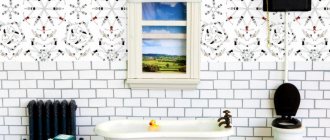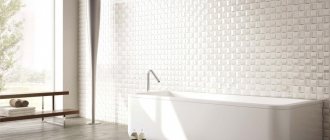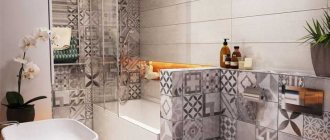A lilac bathroom is considered a classic design option. Calm shades of purple on the floors and walls combine harmoniously with white sanitary ware and gold or silver decorations, giving the interior a complete look. Brighter colors, such as purple or eggplant, are used less often in bathrooms, but they also have a place in modern styles.
Psychological effects of lilac color
The color violet combines warm red and cool blue, so its effect on a person’s mood is dual. When used correctly, it can calm and excite, attract attention and repel: it depends on the shade and characteristics of the environment. The use of different tones of lilac can make the interior minimalistic and strict, homely and cozy, or royally luxurious.
Muted, soft shades of purple have a calming effect. By decorating your bathroom in pastel lavender, violet, and glycine tones, you can create a calm atmosphere for relaxation and relaxation. Such a range will add lightness and smooth out the influence of more catchy colors.
Bright tones of purple (magenta, blackberry) are associated with mysticism and mystery, as well as luxury. They are used carefully in the bathroom: mainly for the design of textiles and decorations. An excess of such colors can make the interior gloomy and oppressive.
Shades with red undertones (eggplant, plum, wine) attract attention and set the mood for action. They are suitable for decorating a bathroom in original, creative styles that differ from pastel classics.
Dark shades of purple evoke sadness and melancholy. They must be used in combination with lighter colors (for example, white), otherwise the interior will become gloomy and uncomfortable.
Why is purple so popular in bathroom design?
The color purple is popular for its innovation, style and personality. The palette of shades is capable of recreating a unique interior that will be relevant for many years. Lilac promotes relaxation, comfort and restoration of mental balance. Decorating a bathroom in this color is suitable for owners of apartments with a small area, as deep shades of purple can reflect light, visually expanding the space.
The color violet is based on two tones: red means strength, power, flow of energy, movement, while blue is associated with calm, comfort and balance. Thus, purple has a strong psychological impact, reflecting the union of soul and body, softness and strength, severity and homeliness.Purple has many subtones and shades, each of which can give the interior a certain meaning:
- Warm: eggplant, orchid, lavender.
- Cold: amethyst, purple, plum, blueberry, lilac.
- Neutrals: lilac, thistle, fuchsia, indigo.
Important!
Surrounding colors can influence our state, mood and peace of mind. Some shades can even have a healing effect, for example, lilac and deep violet are used for the prevention and treatment of high blood pressure, neurological diseases and heart disease.
Varieties of purple tones
Variants of purple are used in bathroom design. Some of them:
- lilac;
- glycine;
- violet;
- lavender;
- bilberry;
- orchid;
- amethyst;
- cyclamen;
- purple;
- blackberry;
- grape;
- eggplant;
- plum;
- wine;
- smoky purple;
- Charoite
Shades differ from each other in color warmth, saturation, and brightness. They are able to influence both the mood and the external perception of the room in different ways.
Oriental style bathroom
Asia has always been mysterious and beckoning. Likewise, a Japanese interior in a lilac bathroom, as in the photo, will create an atmosphere of veil and sophistication.
To create an oriental design, the following accessories are used:
- Wooden furniture.
- Warm colors for finishing surfaces in the bathroom.
- Mosaic made of lilac ceramic tiles.
- A key aspect in the design can be an image of cherry blossoms or a hieroglyph.
- A combination of dark and light purple colors.
- Japanese landscapes on ceramic tiles.
- A traditional fan to support the decor.
- Bamboo accessories.
- Curtains with oriental images.
- Complex lighting system.
The combination of lilac and purple with other colors
You need to combine colors in the interior wisely, emphasizing the advantages of both tones. Popular color partners for purple:
- Neutral tones: white, gray, beige, cream. Complement any shade of purple, adjusting its depth and saturation.
- Pink. Emphasizes the depth and expressiveness of lilac tones, creating a relaxing atmosphere.
- Red. A contrasting color that can be used to highlight accents.
- Green. Cold variations for a calm, cozy atmosphere, while bright and warm ones enhance the effect of luxury from purple.
- Blue. A related color that does not create a sharp contrast, harmoniously emphasizing the grace and coolness of lilac tones.
- Orange, yellow. Used when you need a contrast between warm and cold shades.
- Brown. Combines with purple in eco or country style bathrooms, where the emphasis is on simplicity and naturalness.
It is not recommended to combine purple with smoky, ashy shades; they make it look blurry and nondescript. You should be careful when combining it with black: it is easy to make the interior gloomy and uninviting.
How lilac combines with other shades in interiors
Like blue, orange and yellow, lilac does not have many shades. Therefore, in the decoration of bathrooms it is used with closely related colors or tones of different saturations are combined.
- Orange bathroom - 75 best photo ideas for bright color combinations
Beige bathroom: calm and stylish tones in the design + 76 photos of design ideas
- Self-leveling floor in the bathroom - installation taking into account the characteristics of the room (92 photos + video)
In bathroom interiors, lilac rarely coexists with black, since it is much more appropriate for an elegant contrast:
- purple or violet;
- eggplant;
- blueberry shade;
- indigo (rich blue-violet);
- plum;
- classic dark blue.
The following is most often used as a lighter background in the design of a lilac bathroom:
white;
blurry blue;
pearl gray;
silver;
pale pink.
Tip: The selection of gray shades (companions of lilac) for bathrooms, showers or indoor mini-pools should be approached intelligently.
Judging by the photo of the lilac bathroom, the gray-lilac duo sometimes looks tasteless or it seems that everything is covered with dust.
It is not recommended to use rich lilac or purple as a base color - the room looks cold and somehow “heavy”. This is especially noticeable with convex shapes in decoration, furniture and accessories.
Advantages and disadvantages of this tone in design
Purple in the design of rooms has the following advantages:
- goes well with many companion flowers;
- creates accents without looking vulgar or provocative;
- Suitable for many styles;
- combined with plant and marine themes;
- creates a sensual, relaxing atmosphere;
- can be used as a main (calm, muted, smoky tones) and additional color;
- associated with wealth, makes the room seem more expensive and luxurious.
Disadvantages of this tone:
- visually narrows the room, not suitable for small rooms;
- can cause lethargy and lethargy, so it is not used where a person spends a lot of time (only as an additional color);
- If used incorrectly, it can make the atmosphere in the room cold and gloomy.
The severity of the strengths and weaknesses of purple in the interior depends on the literacy of its use. Proper lighting, combination of shades, arrangement of objects in the room and the use of other design techniques will help highlight the advantages and hide the flaws of color.
Choice of color tones
Purple has many possibilities. A simple lavender bath can become a place of relaxation.
This choice will be the perfect embodiment of a resort hotel. The atmosphere will be filled with romance.
To achieve the same with lilac, you will have to add a little turquoise and plum color.
Choosing an interior style for a bathroom in purple tones
Different shades of lilac will suit almost any room decor style. Popular variations for the bathroom:
- Classic. The white and gold tones characteristic of this style, smooth shapes and rich decor go well with blueberry and purple shades.
- Romanticism. It is characterized by the use of calm, muted shades: lavender, violet, orchid; they will add tenderness and lightness.
- Art Deco. This style is characterized by emphasized luxury and sophistication, which matches purple and other rich variations of purple.
- Country. Uses light, soft shades of lilac, violet, glycine to highlight natural elements.
- Spa. This style uses light tones of lavender combined with green and white to help create an atmosphere for relaxation and relaxation.
- Japanese. It is characterized by a combination of light shades of purple with the color of the national sakura tree.
Purple is combined with metal and chrome elements, so its inclusions are harmonious in high-tech, modern, and minimalist styles. But this color cannot serve as the main tone, since the directions assume a black-white-gray palette.
Classic lilac interior in the bathroom
Classic means a combination of lilac with white, golden and gray shades. The presence of unusual thematic ornaments on cabinets, tiles and other interior elements is an integral addition to a classic interior.
When choosing this style for a bathroom, it is worth calculating the costs and weighing them against the budget, since classic is an expensive trend that requires the highest quality tiling and the use of presentable accessories.
Design ideas
The interior of a purple bathroom should combine furniture, plumbing, and surface finishes. They are complemented with textiles and decor. Creative ideas for design can be seen in the photo: a clear understanding of the designer’s idea will help you choose the best option.
Purple tiles
You can decorate the walls in the bathroom with tiles. If the whole room is lilac, then you need to choose tiles in light, pastel colors, otherwise the atmosphere will be oppressive. In some cases, only part of the room is laid out in purple (for example, a wide strip in the center between the floor and ceiling): then you can choose a brighter shade to create an accent.
Elements of lilac tones are often used in mosaic compositions. With their help, shapes and geometric patterns are created. You can use mosaics to cover the entire wall or a small part of it, for example, an area near the bathroom or sink.
An alternative could be tiles with a pattern. In the bathroom, tiles with images of purple flowers, fish and sea creatures, and shells look good. A more original option would be a wall landscape or still life in lilac tones.
In small rooms, a good solution is to decorate the far wall with lilac tiles and the rest with white tiles. This technique will visually add depth to the room.
Walls and floor
If standard tiles look too boring, the room can be decorated with wallpaper, Venetian plaster, paint: they will emphasize the depth and richness of the purple hue. Unusual finishing options can be used either independently or in combination with familiar tiles: for example, to highlight the far wall or area and sinks.
Light lilac tones are combined with coatings that imitate natural surfaces: wood, stone, sand. They can be used to decorate walls and floors if the bathroom is planned to be decorated in country, Provence, or eco style.
The luxury of purple can be emphasized with textile, metal, and glass inserts. They will bring originality and unusualness to the interior. This solution looks good in a high-tech or minimalist style.
The floor should be in harmony with the walls. To combine them into a single composition, you can use the same mosaic or pattern components or successful color combinations. If the wall decoration is bright and rich, it is better to make the floor lighter and vice versa.
Types of bathroom materials and finishes
Using ceramic tiles has many positive aspects:
- Durable;
- Beautiful;
- Different sizes;
- Easy to clean and less dirty.
And most importantly for design, you can create stunning combinations with tiles. As a rule, dark tiles are laid on the floor, and the walls are made up of several shades. But you can always ignore the rules and, in the case of creating a visual increase in space, use lines of dark colors along the perimeter or from floor to ceiling.
The use of marble tiles plays a huge role in creating a luxurious and at the same time cozy design. The patterns on its surface are so beautiful and natural that they do not require additional decoration. In addition, marble can compete in its characteristics with tiles, since it also has a certain set of qualities necessary for the bathroom.
A cheaper alternative is wallpaper, but you cannot use roll wallpaper, as moisture will instantly cause it to become unusable or fall off completely. Liquid wallpaper can be considered as a good option, but they are also not recommended for use in areas of direct contact with water. That is, the area near the washbasin, bathtub or shower will still have to be decorated with tiles or plastic panels.
Plastic panels have gained wide popularity because they are easy to use, easy to install and dismantle, and also look very good. The panels are mounted on an aluminum profile to prevent rust. It should be noted that they are easy to damage because the layer of plastic is very small.
Selection of furniture and plumbing fixtures
Standard white sanitary ware is suitable for a bathroom in lilac tones. It can be decorated with a pattern or mosaic that is in harmony with the walls and floor. A more original option would be purple bathtubs, sinks and toilets, but they need to be selected carefully. If the decoration of the room is light, they should be 2-3 shades darker, and if it is dark, lighter. It is better not to take brightly colored plumbing fixtures: they will overload the interior. You should also avoid fashionable black and gray items; they will make the room gloomy.
Furniture that imitates natural materials, wooden or stone shelves, wall and floor cabinets, countertops, and niches under the sink are in harmony with lilac walls. If the bathroom is decorated in light colors, glass, metal, glossy stands, nets for hygiene items, and small cabinets look good. They emphasize lightness and visually expand the space.
It is better to take small plumbing fixtures and furniture, with smooth shapes and rounded edges. This will help soften the gloom and coldness of purple.
Interior design and selection of plumbing fixtures
A bathtub or Jacuzzi for a lilac bathroom is traditionally white or pale blue. Such an interior always looks clean and the containers look “sterile”.
Lilac-colored tanks are offered extremely rarely, but they are sometimes made to order for demanding customers.
They can be made in an unconventional manner, for example, in an unusual shape, coated with colored enamel or made from some original materials.
Lilac bidets and toilets are also rare. Most often, white or blue sanitaryware is used.
A toilet of rare shades is often offered complete with a sink, and such a find should not be neglected.
A washbasin and bathtub made in the same design are also a common option. If they don’t have a toilet in the required shade, buy a white one, and select the toilet lid in the required shade.
A shower cabin in lilac design is very rare, but a white one with chrome parts will fit perfectly into a lilac interior.
Accessories can compensate for the missing color balance.
If your bathroom design looks unfinished, add lilac bath curtains or towels, wall cabinets with mirrored doors, or functional furniture with washable fronts in a matching shade.
See even more interesting solutions on this topic in our photo gallery.
Textiles for a lilac bathroom
Textile elements for the bathroom in purple tones should match the overall design of the room. The following will help you decorate your room successfully:
- carpets made of fabric or wool create color harmony between the floor and walls without additional repairs;
- a curtain between the bath or shower; it can be decorated with a thematic pattern or gradient in lilac tones;
- fabric lampshades on lamps dim the lighting (in a room with an abundance of purple tones it should not be too bright), while simultaneously serving as additional decor on the ceiling;
- window curtains will both decorate and protect privacy during hygiene procedures;
- towels and bathrobes in harmonious or contrasting colors create accents and highlight other decor.
Purple is combined with textured fabrics: velvet, velor, satin, corduroy. It emphasizes the grace and luxury of these unusual materials.
Design options
A purple bathroom is an excellent solution for bold and romantic people. It's nice to dream in it and relax while taking a fragrant bath. This range is successfully used in a variety of styles.
The beneficial effect of such a palette on the human psyche will allow you to immerse yourself in relaxation and bliss in a beautiful and elegant room.
Decorative elements for a purple bathroom
Decorations for the bathroom should create accents or highlight the features of other interior elements. As decor for a purple bathroom you can use:
- beautiful soap dishes, glasses for toothbrushes, jars for hygiene products can be selected by color and harmoniously placed on the shelves;
- decoratively designed coasters, towel hooks, taps, hoses, shower heads in golden or silver tones will give the bathroom an expensive, luxurious look;
- candles, bathing bombs, handmade shaped soap are suitable for a bathroom in any style and color scheme;
- mirrors are a traditional bathroom decoration that visually expands the space;
- stones, shells, wooden or stone figurines and other natural elements will complement the room, made in eco-style;
- glass and metal decorative items can be used in a bathroom in modern or high-tech style;
- fresh flowers (lilacs, violets, crocuses, irises, hyacinths, orchids) will add freshness and liveliness to the interior;
- small decorative lamps throughout the room instead of a ceiling chandelier will help decorate the bathroom while adjusting the level of lighting.
Unlike decoration, furniture and plumbing, bathroom decor can be changed at any time. Therefore, you should not be afraid of experiments and bold decisions.
Colorker Vivenza
Blueberry shades combine effectively with white and gold details. The white and purple Colorker Vivenza tiles are suitable for those looking for an elegant and discreet solution.
A “gold-look” border with a complex relief ornament will add a special charm to the decoration.
In the photo: Colorker Vivenza ceramic tiles in shades Amethyst and Pearl .
Purple tiles for the bathroom in the ART REAL salon
Looking to buy purple bathroom tiles? We can offer you ceramics of any shade: lilac, lavender, lilac, fuchsia, blackberry or blueberry. The assortment of the ART REAL salon includes more than 2000 collections in stock and on order.
From any of the collections you like, our specialists will prepare a design project and lay out the layout of the tiles in the room.
You can view samples from the collections on the website, as well as select tiles from the “made to order” catalog in the ART REAL salon. Come! We work every day!
Tags: Tile , Ceramic tiles , For the bathroom , For the kitchen , Naxos , Mosaic , Panels , Imola Ceramica , Petracers , Patchwork , Emil Ceramica , Latina Ceramica , Damascus , Abita , Colorker , Gold , Italian Tiles , Relief border , Latina Ceramica Layla , Colorker Vivenza , Abita Vision , Petracers Primavera Romana , Emil Ceramica Giselle , Mora , Naxos Florence , Pearl , Amethyst , Imola Ceramica Cento per Cento , Violet , Violet , Lilac











